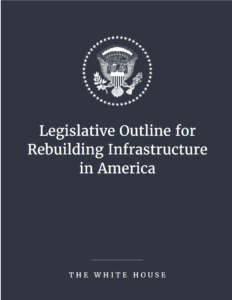 The growing national attention to public infrastructure in the United States has been gratifying to those of us who have been working on the issue for a long time. Infrastructure has been a simmering issue for decades, but a spate of recent high-profile disasters has pushed it to the forefront of American politics. It was a major theme in the 2016 presidential election, and last week the White House announced president Trump’s long-awaited infrastructure plan in a 55-page document.
The growing national attention to public infrastructure in the United States has been gratifying to those of us who have been working on the issue for a long time. Infrastructure has been a simmering issue for decades, but a spate of recent high-profile disasters has pushed it to the forefront of American politics. It was a major theme in the 2016 presidential election, and last week the White House announced president Trump’s long-awaited infrastructure plan in a 55-page document.
I’ve had a chance to review and reflect on the proposal; in this inaugural blog post and a few posts to follow, I’ll share some observations about White House’s infrastructure plan. I’m going to focus on the infrastructure plan itself, and in ways that can maybe add some value to the public discourse. So in this series of posts I won’t comment on the president’s budget proposal or regulatory actions—I’ll just stick to the 55-page plan. This post will discuss the White House infrastructure plan’s broad financial elements, since adequacy of finance has garnered most attention. In future posts I’ll address privatization, water infrastructure, and workforce aspects of the plan… and maybe other stuff, too.
Federal funding as federal leverage
America’s infrastructure funding needs are enormous. Drinking water systems alone will require more than a trillion dollars over the next 25 years to maintain health and economic growth. Sewer systems need more than $271 billion over the next two decades. Replacement and repair costs for railroads, highways, bridges, seaports, airports, dams, levees, and myriad other systems are enormous. Even conservative estimates of infrastructure needs put the price tag into the trillions of dollars.
In the face of those daunting figures, the White House plan calls for about $200 billion in federal infrastructure funding, $50 billion of which is to be targeted at rural and tribal infrastructure. The most common critique has been disappointment in the scale federal commitment under the plan (for example), and no one seriously argues that $200 billion is adequate to address the nation’s infrastructure needs. The president’s plan seeks to use the federal contribution to spur local, state, and/or private investment by offering a 10-20% match. That is, a local government could propose a $100 million project; if approved, the federal government might contribute up to $20 million, with the local government responsible for raising the remaining $80 million from other sources. In that way, the federal government essentially subsidizes local/state/private infrastructure investment.
This arrangement is typical for federal infrastructure funding from the 1950s-1970s. Comparatively little of the nation’s critical infrastructure is actually owned by the federal government; most is owned and operated by state/local governments or private corporations. For highways, ports, and water/sewer systems in particular, the great federal spending programs of the past have been set up as proportionate matches or grants-in-aid for construction. In most cases, this cooperative arrangement was a central to the legislative coalition that came together to fund infrastructure. The idea is for the federal government to spur construction, then turn infrastructure over to state/local government for ongoing maintenance and replacement.
The main difference between the White House’s infrastructure funding proposal and the great federal infrastructure programs of decades past is the share of the federal contribution: Uncle Sam paid for 90% of construction costs under the 1956 Interstate Highway Act and 75% under the Clean Water Act, for example. To put things in perspective, the Clean Water Act’s $57 billion of local grants-in-aid would be more than $300 billion in today’s dollars.
State & local governments on the hook
But for a variety of reasons, many local and state governments have not adequately maintained, replaced, or expanded infrastructure. In some cases, disasters or economic decline have made adequate funding difficult. More often, though, state/local politicians find it easier to neglect infrastructure than to maintain it adequately. Repair and reinvestment aren’t very sexy, and politicians everywhere prefer lower taxes and user fees. Hence the multi-trillion-dollar infrastructure costs facing the nation.
Would a larger federal contribution than called for in the Trump plan help close the gap? Absolutely. But the days of federal largesse underwriting infrastructure in the 1950s-1970s are probably over. With entitlements, defense, debt and tax expenditures sucking up the lion’s share of the budget and politicians loathe to raise taxes, it’s difficult to imagine a trillion-dollar federal infrastructure initiative in near future.
Put simply, there is little Congressional appetite for massive federal investment in local and state infrastructure today. The most useful way to think about the White House funding plan is not to compare it to the Interstate Highway Act or Clean Water Act (when the feds paid a lot), but rather to the status quo (when feds pay virtually nothing). It’s exceedingly unlikely that the federal government is going to foot the whole infrastructure bill, or even half of it. State and local officials complaining about federal government failure to pay for their infrastructure replacements is like dinosaurs complaining about asteroids.
Leveraging what?
Capital for infrastructure has to come from somewhere. Under current political and fiscal conditions, the best prospect for effective federal financing is probably to entice other sources of capital into public infrastructure. That’s what the White House’s plan tries to do. Whether $200 billion is adequate to the task is hard to say.
I’ll take up the thorny question of infrastructure privatization another day.
